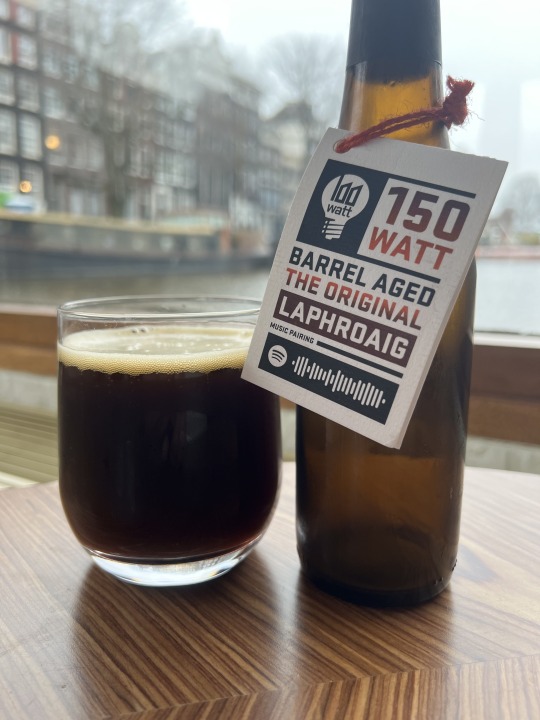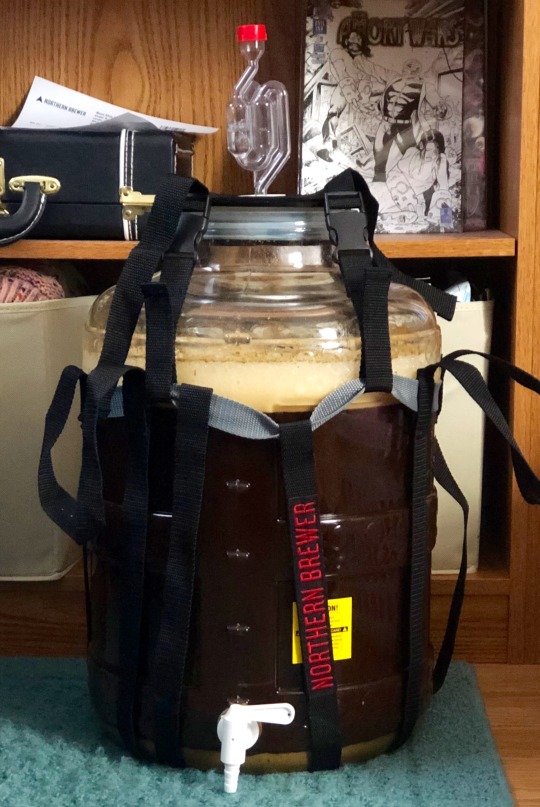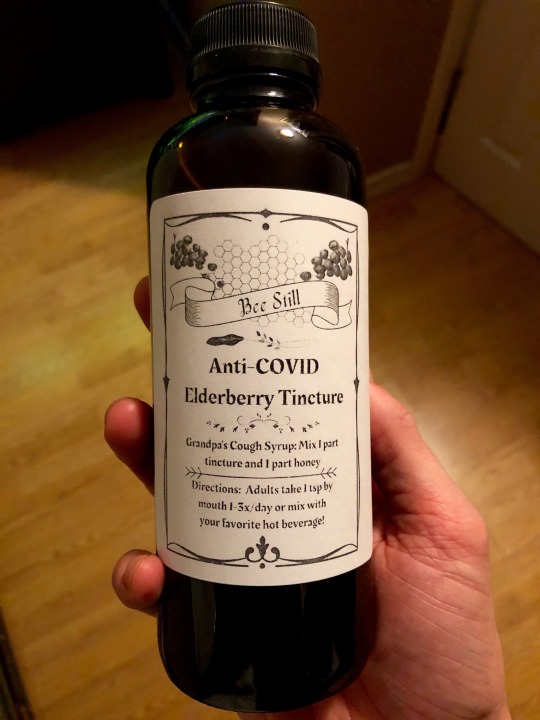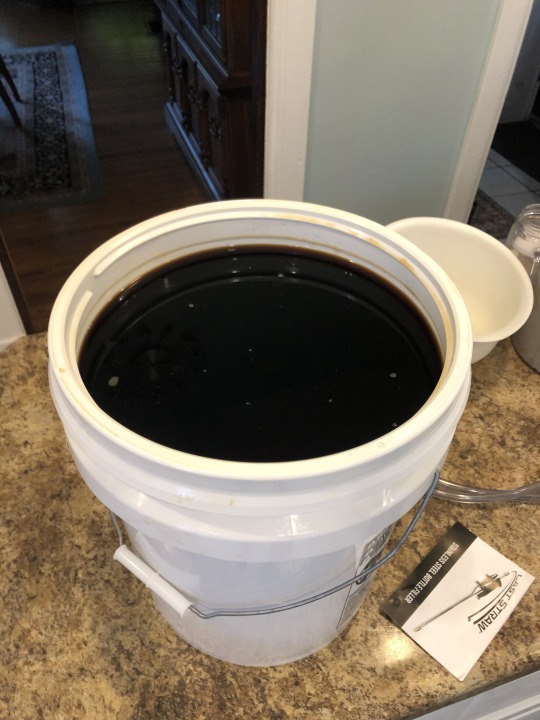#Belgian Quadrupel
Explore tagged Tumblr posts
Photo

100 Watt Brewing 150 Watt Barrel Aged Laphroaig (Picked up at Sterk in Amsterdam). A 3 of 4. The barrel adds a nice peaty quality to the Belgian quadrupel that serves as the base. Lots of dark fruit and roast notes in the beer, as well as the expected barrel and peat. Quite nice.
7 notes
·
View notes
Text

Review #17
Got a bit excited and drank some before I snapped a picture lol. Beautifully balanced beer. At 10% it tastes so smooth and malty and fruity loved this one. 9/10
1 note
·
View note
Text

+ day drinking on top of this morning’s activities.
Double Bonus Win for today.
8 notes
·
View notes
Text
Ales Unleashed: The Vast Brew World of Possibilities

Introduction
In the world of libations, few beverages can rival the diversity, complexity, and sheer exuberance of ales. Ales have transcended their humble origins to become a worldwide sensation. Whether you're a seasoned beer enthusiast or just dipping your toes into the brew world, this comprehensive guide will take you on a journey through the vibrant and multifaceted universe of ales.
What is Beer Made Of?
Before we dive headfirst into the captivating world of ales, let's address the fundamental question: what is beer made of? This iconic beverage comprises four core ingredients, each playing a pivotal role in shaping its flavor, aroma, and character:
1. Water: The Liquid Canvas
Water serves as the canvas upon which the masterpiece of beer is painted. It makes up the majority of beer's composition, typically accounting for 90-95% of its content. The source and mineral composition of water profoundly impact the taste and quality of the final product.
2. Malted Barley: The Heart of the Brew
Malted barley, often referred to as the soul of beer, provides the essential sugars needed for fermentation. During the malting process, barley grains are soaked, germinated, and dried, activating enzymes crucial for the conversion of starches into fermentable sugars. The type and roast level of barley influence the beer's color, flavor, and body.
3. Hops: The Aromatic Enhancers
Hops are the spice of beer, responsible for its bitterness, aroma, and flavor. These cone-shaped flowers contribute a delightful array of scents, from floral and citrusy to earthy and piney. Hops not only balance the sweetness of the malt but also act as a natural preservative.
4. Yeast: The Magical Microorganisms
Yeast, the unsung hero of brewing, transforms sugars into alcohol and carbon dioxide through the process of fermentation. It's the yeast strain that determines whether a beer is an ale or a lager, and it imparts a plethora of flavors and aromas, from fruity esters to spicy phenols.
Now that we've established the essential ingredients of beer, let's embark on an odyssey through the enchanting world of ales.
The Ale Family Tree
Ales are a diverse and expansive category of beer, characterized by their use of top-fermenting yeast strains, which ferment at warmer temperatures. This family tree of ales can be broadly categorized into several substyles:
1. Pale Ale: The Trailblazers of Flavor
Pale ales are the pioneers of the craft beer movement, renowned for their balanced and approachable character. They offer a harmonious blend of malt sweetness and hoppy bitterness. Subcategories like American Pale Ale (APA) and India Pale Ale (IPA) have gained worldwide fame.
2. Amber Ale: A Toast to Tradition
Amber ales exude a warm, amber-hued appearance and a rich malt-forward flavor profile. They often feature caramel and toasty notes, making them a comforting choice for those seeking a taste of tradition.
3. Brown Ale: The Nutty Delight
Brown ales, known for their nutty and chocolatey undertones, are a delightful treat for the palate. These beers span a spectrum from mild and sweet to robust and roasty.
4. Porter: The Dark Elegance
Porters are the epitome of dark beer elegance. With flavors ranging from coffee and chocolate to smoky and earthy, they offer a complex and indulgent drinking experience.
5. Stout: The Bold and Beautiful
Stouts are a robust and hearty category, boasting dark, velvety flavors. From classic Dry Stouts to Imperial Stouts with their high alcohol content, these brews encompass a wide range of tastes and textures.
6. Belgian Ale: The Art of Abundance
Belgian ales are renowned for their complexity and artistry. They encompass a dizzying array of substyles, including Trappist ales, Dubbels, Tripels, and Quadrupels, each with its unique flavor profile and yeast characteristics.
7. Wheat Ale: The Refreshing Twist
Wheat ales are known for their light and refreshing qualities. With a substantial portion of wheat in the grain bill, they often exhibit fruity and citrusy notes, making them perfect for warm-weather sipping.
8. Sour Ale: The Tangy Rebellion
Sour ales defy convention with their tart and acidic nature. From Berliner Weisse to Lambics and Goses, these beers challenge the palate with their complex and puckering flavors.
The Brewing Process: Crafting Ale Magic
Brewing ales is a captivating blend of art and science. While the process may vary slightly depending on the style, here's a simplified overview of how ales come to life:
1. Mashing: Crushed malted barley is mixed with hot water in a process called mashing. This activates enzymes that convert starches into sugars, creating a sugary liquid called wort.
2. Boiling: The wort is boiled, and hops are added during this stage. The boiling process extracts flavors and bitterness from the hops while sterilizing the wort.
3. Fermentation: After boiling, the wort is rapidly cooled and transferred to a fermentation vessel. Yeast is added, and the magic of fermentation begins. The yeast consumes sugars, producing alcohol and carbon dioxide while imparting unique flavors.
4. Conditioning: Depending on the style, ales may undergo further conditioning. Some are aged in barrels, while others are conditioned in tanks or bottles to develop their desired characteristics.
5. Packaging: Once the beer reaches its optimal flavor profile, it's packaged in bottles, cans, or kegs, ready to be enjoyed by enthusiasts worldwide.
The Art of Ale Appreciation
Appreciating ales goes beyond mere consumption; it's an art form. Here are some tips to elevate your ale experience:
1. Glassware Matters: Choose the appropriate glassware for your ale style. Tulip glasses, pint glasses, and snifters are all designed to enhance aroma and flavor.
2. Temperature Control: Serve your ales at the correct temperature. Consult style guidelines, but generally, ales are best enjoyed between 45°F and 55°F (7°C to 13°C).
3. Savor the Aroma: Take time to inhale the aromas before each sip. Ales offer a plethora of scents, from floral and fruity to earthy and spicy.
4. Pairing Pleasures: Experiment with food pairings. Ales' diverse flavors complement various cuisines, from spicy dishes to decadent desserts.
5. Responsible Enjoyment: Always savor your ales responsibly. The journey is just as enjoyable when you're mindful of your limits.
The Ever-Evolving Ale Landscape
As the craft beer movement continues to surge, ales remain at the forefront of innovation and experimentation. Brewers are constantly pushing boundaries, creating bold new flavors, and resurrecting forgotten styles.
From barrel-aged wonders to fruit-infused experiments and wild yeast concoctions, the possibilities in the world of ales are boundless. As you explore this diverse universe of beer, remember that the most profound journey lies in the endless exploration of flavors and aromas.
Conclusion
Ales have evolved from humble beginnings into an extraordinary tapestry of flavors and styles. With a rich history, diverse subcategories, and a vibrant brewing culture, they offer a world of possibilities for beer enthusiasts. Whether you're sipping a classic Pale Ale or indulging in a complex Belgian Trappist, ales have something to offer every palate. So, go forth, explore, and savor the wondrous brews of the ale world, and may your beer adventures be boundless and ever-enjoyable.
1 note
·
View note
Text
Pairing tobacco and beer: finding the perfect combination
Tobacco and beer have been enjoyed together for centuries, with many people finding that the right pairing can elevate both the flavors of the tobacco and the beer. Whether you enjoy cigarettes or cigars, there are a variety of beer styles that can complement the tobacco and enhance the overall experience. In this article, we'll explore the art of pairing tobacco and beer and provide some tips for finding the perfect combination.
Cigarettes and beer
Pairing cigarettes with beer is a popular combination among smokers. The best beer to pair with cigarettes is one with a high bitterness level, such as an IPA or a stout. The bitterness in the beer can help cut through the smoke and cleanse the palate, making each puff taste more enjoyable. The carbonation in beer can also help clear the taste buds, enhancing the overall experience.
If you prefer a milder cigarette, then a lighter beer such as a pilsner or lager may be a better pairing. These beers have a more subtle flavor that can complement the tobacco without overwhelming it.

Cigars and beer
When it comes to pairing cigars and beer, there are a few more factors to consider. The flavor of the cigar can vary greatly depending on the tobacco blend, and the strength of the cigar can also affect the pairing. As a general rule, it's best to pair full-bodied cigars with full-bodied beers and milder cigars with lighter beers.
For full-bodied cigars, such as a Maduro or a Habano, a dark beer such as a porter or a stout can be a great pairing. The rich, roasted flavors in the beer can complement the earthy and spicy notes in the cigar. A Belgian Dubbel or a Quadrupel can also be a great pairing, as the sweetness in the beer can balance the bold flavors of the cigar.
For milder cigars, such as a Connecticut or a Corojo, a lighter beer such as a pilsner or a wheat beer can be a great choice. These beers have a more subtle flavor that can complement the tobacco without overpowering it. A fruit beer or a sour beer can also be a good choice, as the acidity in the beer can help cut through the richness of the cigar.
Conclusion
Pairing tobacco and beer is an art that takes time and experimentation to perfect. By considering the flavors and strengths of both the tobacco and the beer, you can find a pairing that complements both and enhances the overall experience. Whether you prefer cigarettes or cigars, there is a beer out there that can take your smoking experience to the next level. Visit a local tobacco and beer shop and ask for their recommendations for the best pairing for your favorite tobacco.
0 notes
Text
God Loves Beer

"I know some conservative Christians who think it's a sin to have even a taste of beer," I told my mom last week. Her response? "I know. I used to be one of those Christians." To be fair, she had a good reason. My dad struggled with alcohol throughout their marriage. But her view has changed in recent years, which is a good thing since alcohol is a pretty big part of my life. Really big, actually. Especially since brewing became my #quarantinehobby. Beer, wine, mead. The process of home brewing fascinates me and really scratches my creative itch. I love the nuances of different flavors, and there's seldom a meal that I don't pair with some form of alcohol. So, yeah, it'd be a problem if my mom believed I was "living in sin." But the thing is, there are plenty of people who think I AM. And there are a plethora of other lifestyles that plenty of people believe fall into this "living in sin" category, as well.

Ironically, I believe passing judgment on others is often a sin. I've watched friends condemn individuals and entire populations for things that are central to who they are, and those condemnations lead to some of the worst atrocities on the planet. If "sin" can be defined as "setting something up as more important than God," then I know plenty of Christians (and non-Christians) who live in the sin of judging others. Of course, these situations are rarely that simple. The Bible instructs us to rebuke our brothers and sisters in Christ (church language for setting other Christians straight when we see them going down the wrong road), but I haven't met a Christian yet who fully knows the heart and mind of God. Sure, we have an instruction manual, a book that chronicles the history of rules, instructions, advice, and mistakes of Christianity from before Christ was even born. But it's a big book. And it was written a long time ago, in foreign cultures, and in a lot of different languages. Yes, every one of those words were God inspired, but the problem isn't with the words. It's with the people who read them.

"Studies show that there's no difference between wearing a mask and not wearing one." "Polls show that police brutality is at an all-time high." "There's no proof that banning guns would lower crime rates." "Michael Jordan's stats prove that he was the best basketball player of all time." I took a class in college that taught me how to interpret research articles (yes, just ONE class), and the main thing I took away from it was that bias is the bane of truth. Bias from researchers, those funding the research, and those reading the research—it happens at all levels, and it basically allows us to hear whatever we want to because there are SO MANY nuances to trying to separate objective facts from subjective belief. We try to wrangle them, try to pin them down and separate them out, but the universe is a big place, and NO ONE is capable of processing all of it clearly. No one except God, of course. And since, as I said, none of us has the Big Man's cell phone number (not that we would listen even if we did since), we're left to interpret pretty much everything with at least a little of our own bias. Where we grew up, what our genetic makeup is, what our parents believed, etc., etc. Like my mom's condemnation of alcohol because of the very real pain it caused her marriage, bias influences every thought we have.

I grew up in a Christian household in rural Missouri. So, I'm a Christian. Yes, it was a choice. Yes, I've spent decades reading, listening, contemplating, and trying to "prove" my beliefs, but if I'd grown up as a Muslim in the heart of Pakistan, I'd probably be Muslim. And I'd probably be one of those individuals who believes taking a sip of alcohol is a damnable offense. Thankfully, I didn't. Otherwise, I never would have experienced the joy of my first home brewed Belgian quad beer. I'd never have felt the complexities of its sweet maltiness as it flowed over my tongue. I'd never have enjoyed the thrill of accomplishment at not blowing up my basement as I figured out how to keg that beer. I'd never have delighted in the freedom of "knowing" what I did came from my God-given creativity—a creativity that I believe reflects the Great Creator's heart in a pure and intimate way.

As I said, nothing is ever simple. I'm not suggesting that we should live a hedonistic "everything goes" lifestyle. We DO need to make choices. We DO need to draw lines and strive to keep others from cheapening Gods grace. But we shouldn't do those things the easy way. If you believe I'm sinning by drinking alcohol, you should figure out WHY you believe that. Not because you read a single sentence out of the Bible and used it (perhaps out of context) to justify your own personal beliefs (which came from countless sources OTHER than God). In short, be intentional. Be discerning. Be patient and kind. Live by the GREATEST commandment to love God first. Love others as yourselves. And take the time to filter all of your other beliefs through that lens. Use the Bible as a guide, not a weapon. And maybe chill out and have a frosty home brew once in a while. I know where you can find some.

#home brew#homebrew#beer#belgian quad#belgian beer#northern brewer#momblr#mumblr#dadblr#christianity#faith#golden rule#belgian quadrupel#grace
1 note
·
View note
Text


Stopped with the Craft Brewing Club from work at a new place (for me). Grist Brewing in Lone Tree. The taster is Sucker Punch Sour and the 10 oz. is Steam Monk Strong Belgian Quadrupel. The sour was nice an tart, and the quad was big and bold. I loved sitting on the upper deck on a gorgeous Colorado evening.
#steam monk strong#belgian quadrupel#grist brewing#beer#brewing#craft brewing#craftbeer#craft beer#colorado#lone tree#quadrupel#sour
1 note
·
View note
Photo

Malheur 12°
7 notes
·
View notes
Photo


A Feat of Strength
It’s that time again. The lasagna is in the oven. The fruitcakes are wrapped and ready to go. The presents are under the tree. We’ll be celebrating with friends and family in a few short hours.
But there’s still time for a beer. Friar’s Festivus is Monkless’ entry into the Belgian holiday ale canon. If you look closely, you can see the traditional aluminum pole, chosen for its a high strength-to-weight ratio, depicted on the label. The beer itself has an equally impressive lightness and power. The aroma bursts from the bottle with big notes of banana and a holiday spice. The flavor it bold like rum soaked raisins or a bundt cake baked with bananas instead of eggs. A balancing bitterness is followed by an intensely dry finish. Despite clocking in at over ten percent alcohol by volume, Friar’s Festivus feels light and fizzy on the tongue.
Christmas may have its St. Bernarduses and its Delirium Noels, but Monkless makes a great Festivus Ale for the rest of us... ale?
#whatchudrinkin#monkless#friar's festivus#festivus#seinfeld#craft beer#belgian#christmas ale#holiday beer#craftbeer#indie beer#quadrupel#quad#belgian quad
2 notes
·
View notes
Text

Review #16
I am quite a fan of La Choufe so I was excited to find the Belgian Dark Strong Mc Choufe. A beautifully delicious dark beer with all of the fruity ale notes I love and a malty complexity that beings it all together. It felt a bit lighter than other quads I’ve had but a beautiful beer none the less. 8.5/10
0 notes
Text
Lupita & The 3 Kings (5 Rabbit)

Brewery : 5 Rabbit Cerveceria Beer : Lupita & The 3 Kings Style : Quad / Quadrupel / Belgian Quad Variance : Brewed with Cherries, Candied Pineapple, Cinnamon, and Orange Peel
8.5 / 10
Damn, I seriously feel like because of this beer I might try and convert to Mexican. Can you do that? No? Oh well, it’s probably for the best seeing as who is currently our president and what’s going on in our country with immigrants right now. To be honest, I’d rather be white and drinking this wishing to be Mexican than Mexican getting deported wishing I was American drinking this beer. Basically, our president is a dick. Our nation is founded by immigrants and just because they aren’t the same race as they were when we were started as a country or when your family first came here, it doesn’t make them any less so let’s cut the shit. That’s enough on that issue because half of you probably already stopped reading this. This beer is inspired by a Mexican pastry eaten on Three Kings Day known as Rosca de Reyes which kinds of looks like what would happen if a bagel and a fruit cake had a sexy time love making session and had a super weird pastry child. A nice strong boozy dark fruit flavor starts things off with some candied fruit flavor mixing in quickly after with hints of that orange peel and cherry before closing with a smooth sweet mixture of all of those flavors with some cinnamon coming through to close things up. This is definitely a super interesting variation of the style and if you are just into great beer in general, pick this up and let it open your mind to what is possible with a Quad. For you newcomers out there this is definitely a great entry point into the style and craft in general because even though that 10% ABV is completely noticeable, the rest of the additions will have you coming back for more and more until Lupita on the label finally drops those jeans and let’s you see that fat ass. Salud!
Written by: Steve B.
#review#5 rabbit#5rabbit#quad#quadrupel#belgian quad#beef#craft beer#craftbeer#immigration#trump#drumpf#mexican#rosca de reyes#three kings day
18 notes
·
View notes
Photo

#Repost @colvinology St Bernardus Abt 12, an absolutely world class 10% Belgian Quadrupel from Brouwerij St. Bernardus (@stbernardus), and the Master Grade 0RX-013 Gundam Mk-V . Hey. This is one of my favorite beers of all time. I've been drinking it pretty much since I got into beer, and it's been a while since I reviewed it, so let's do an update. The nose is dark and malty, with aromas of dark rye bread, molasses, caramel, roasted malts, dried fruit, and Belgian yeast. The sip has a malty smoothness that I've seen a lot of beers emulate, but very few successfully replicate. The sip starts off with a malty, almost sweet brown sugar and molasses flavor, along with just a bit of burnt sugar bitterness. Flavors of raisins and dates pour in afterwards and a nice, hefty hit of rum-soaked rye bread shows up right towards the end. Those bitter flavors stay mild, but linger between sips, where they meet the last of those leftover bread and fruit flavors and melt into a boozy, warming finish. One of the first styles of beer I knew I really loved was Belgian Trappist ales. Bernardus then, has the benefit of not just being one of the best quadrupels I've ever had, but also being freely available literally anywhere with a decent beer selection. I honestly can't think of a bottle shop I've been to in the last 10 years that didn't have some Bernardus on the shelf. What I'm saying is, if you haven't had this one, I'm reasonably certain just about everyone in several countries can go out and basically trip over some. There's not much else to say here; some beers don't age well, but no matter how much my palate grows or changes, A chilly bottle of this always hits the spot. Truly and completely a world class beer. . Oh, and while I have you...kinda bullshit that the Gundam Mk-V was a P-Bandai release, right? It honestly a kickass kit and nobody can't find one anymore. Cheers 🍻🍻 . . . . . . . . . . . #stbernardusabt12 #stbernardus #gundamsentinel #gundammkv #Gundam #gunpla #ガンダム #건담 #ガンプラ #건프라 #バンダイ #プラモデル #반다이 #beer #beertogrlaphy #craftnotcrap #beerandgundam #beerstagram https://www.instagram.com/p/CepQ7sSpYQn/?igshid=NGJjMDIxMWI=
#repost#stbernardusabt12#stbernardus#gundamsentinel#gundammkv#gundam#gunpla#ガンダム#건담#ガンプラ#건프라#バンダイ#プラモデル#반다이#beer#beertogrlaphy#craftnotcrap#beerandgundam#beerstagram
6 notes
·
View notes
Text
Chicago Beer Pass: Cheerio

Welcome to the Chicago Beer Pass: Your ticket to all the great beer events happening in and around Chicago.
On this episode of Chicago Beer Pass, Brad Chmielewski and Nik White are cracking open a bottle of The First Five from Temperance Beer Co. as they chat about London. Not only did Brad travel across the pond for tasty London beers but Nik had the chance to experience a new London porter inspired beer that Goose Island released.
As summer creeps in there are a lot of events happening in May especially with Illinois Craft Beer Week coming up! The guys will be covering a lot of these events and a couple of special interviews that should be hitting your podcast feed soon.
Hope you enjoyed it and if there is anything you’d like to see us cover, let us know on Twitter.
Having issues listening to the audio? Try the MP3 (46.4 MB) or subscribe to the podcast on iTunes!
#podcast#audio#audio podcast#temperance#Temperance Beer Co.#The First 5#craftbeer#craft beer#chicago#Brad Chmielewski#Nik White#Quad#Quadrupel#Belgian#chicago craft beer week#Illinois Craft Beer Week#drinking#beer talk
0 notes
Text
Herevana - Bootleg - Belgian Firings-Quad
Herevana – Bootleg – Belgian Firings-Quad
Bootleg Belgian Firings-Quad. Double down from the Dubbel I just had, of course, why go the one when you can go them all. Bootleg Brewery Ltd make the Bootleg Belgian Firings-Quad in the lovely Matangi, Waikato, New Zealand, and this one is a Quadrupel / Abt with an ABV of 8.6% and 20 IBU, this 500ml bottle is 3.4 standard drinks in NZ Beer born on the 7th September according to the label.…

View On WordPress
1 note
·
View note
Text
Introducing St. Feuillien FIVE, by Brasserie St. Feuillien. A new bottle-conditioned specialty Belgian blond ale .

image courtesy Brasserie St. Feuillien
Press Release
North America … Artisanal Imports is excited to announce that world-renowned Belgian brewer Brasserie St. Feuillien has added a new bottle-conditioned specialty Belgian Blond Ale to its offerings with St. Feuillien FIVE, which is now available nationwide in draft format with bottles following in late April.
St. Feuillien FIVE is a refreshing 5% ABV bottle-conditioned pale blond ale with a strong, sparkling character emitting fine bubbles. Delicate fruity hints empowered by nuances of citrus zests give way to a delightfully fresh and hoppy aroma. It is a flavorful, sweet and malty and full-bodied beer with a pleasant balance post-bitterness, and it pours with a stable head of white foam.
“We are thrilled to offer our retailers a new Belgian ale drinking experience this year with St. Feuillien FIVE,” says Bob Leggett CEO of Artisanal Imports. “The beer on draft is a refreshing welcome to warm spring days and the bottles are an excellent new addition to cellars as the yeast continuously adds complexity to the liquid.”
St. Feuillien FIVE is packaged in 330 ml 4-packs, six to a case, and 1/6 bbl U.S. Sankey kegs. St. Feuillien FIVE will accentuate the already outstanding portfolio of the St. Feuillien brand, which includes Grand Cru, Tripel, Quadrupel, Cuvee de Noel, Blonde, Saison and Grisette. St. Feuillien’s products are available in the following states: AK, AZ, CA, CT, CO, DE, FL, GA, HI, ID, IL, IN, KS, KY, LA, ME, MA, MD, MI, MS, MO, MT, NE, NV, NH, NJ, NM, NY, NC, OH, OR, PA, RI, SC, TN, TX, UT, VA, VT, WA, WV, WI and WY.
Interested in selling St. Feuillien FIVE in your retail store, bar or restaurant? Interested in becoming a distribution partner for Brasserie St. Feuillien? Please contact Crystal Bunger with interest.
…
About Brasserie St. Feuillien: Brasserie St. Feuillien ("Foo-Yen") is the maker of some of the world’s most highly regarded Abbey Ales including the notable St. Feuillien Grand Cru, Saison, Blonde, Quadrupel and Tripel. The brewery started in the 7th century, when an Irish monk named Foylan, a name that later morphed into the more French "Feuillien", was killed in the village of Le Roeulx. A chapel was built in his honor that became the Abbey St-Feuillien du Roeulx. Brasserie St. Feuillien is one of the oldest and most well-respected Abbey Breweries in Belgium. Founded by a Female Brewer in 1873, St. Feuillien is still in the family and led by a dynamic female five generations later with proceeds from each sale still going to the Foundation formed in St. Feuillien’s name.
Learn more at www.st-feuillien.com.
from Northwest Beer Guide - News - The Northwest Beer Guide https://bit.ly/3conbkd
1 note
·
View note
Text
Bishop's Barrel #21 Lifts Me To Heaven, While God Remains Ever Out Of Reach. Part Two:Wings.
Bishop’s Barrel #21 Lifts Me To Heaven, While God Remains Ever Out Of Reach. Part Two:Wings.
Another Eduard von Grütznerpainting and another pour of beer. He’s a happy looking monk isn’t he, well so am I, and so are bishops, monks don’t just have all the fun. And yet when it comes to reaching the Lord, of course, he, she, it, them remain forever out of reach despite voices in our heads, visions, and speaking in tongues, no the almighty remains ever out of reach, and a good thing to,…
View On WordPress
#Belgian Quadrupel#Bishop&039;s Barrel Series#Eduard von Grützner#Job#Premium Draught#Saint Arnold#The Cure#Woodford Reserve
0 notes